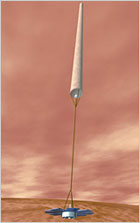
Q. Is there any international collaboration around Japan's balloon-borne experiments?

Cosmic antimatter search by Japan-U.S. collaboration (courtesy: BESS Collaboration)
Many Japanese groups have conducted joint research with scientists overseas. We have performed balloon-borne experiments in the United States, India, Norway and Russia. Large countries with plenty of space have the advantage of being able to use giant balloons to launch heavy payloads – weighing more than 1,000 kilograms – and to recover them on land. Examples of our international collaborations include:
-An experiment with NASA in northern Canada to determine the energy spectrum of antiprotons in cosmic rays. The observations were carried out for almost ten years starting in 1993, and I used to participate in the balloon campaign in Canada every summer.
-A similar experiment at the McMurdo Station in Antarctica, in 2004 and 2007.
-Infrared observations with India since 1996.
-A joint experiment with a Brazilian group, started in 2005.
-In the Southern Hemisphere, we can study the Galactic Center , which we cannot observe from Japan. We are also very interested in a joint experiment with Australia to implement a very long flight of a superpressure balloon.
-For another experiment abroad, we collaborated with the National Institute of Polar Research at the Showa Station in Antarctica. We observed ozone and atmospheric trace components over the station with the Polar Patrol Balloon (PPB), which is capable of extended flight. We also studied magnetic fields, electric fields, aurora X-ray, and electron beams.
International collaboration integrates the different advantages of the participating countries. I think that collaboration will continue to increase, in order to maximize scientific results and achievements with limited budgets. Furthermore, in the future, when new technology enables longer flights, balloons will be flying over many different countries. There are international treaties for aviation and space, but not yet for balloons. International collaboration for scientific ballooning should be encouraged and developed further.

JAXA's planetary balloon research
Q. What is the future direction of balloon-borne experiments?
First of all, we'd like to set a new record by achieving an altitude of 55 km or more, with a balloon made with state-of-the-art ultra-thin film. We'd also like to accomplish an ultra-long flight with a superpressure balloon. The U.S. is also developing a superpressure balloon, but with a different fabrication from ours. We are both getting close to the stage of practical application.
A superpressure balloon will be able to fly for 100 days, so we expect it to be competitive with satellites in some fields of observation. In addition to generating new space science with next-generation balloons that can fly higher and longer, I hope to make balloons more attractive and available for scientists in many different areas of research. In the meantime, research on planetary balloons is now in progress for exploring planets with atmospheres, such as Mars and Venus. We need to invent new materials as well as inflation and transportation methods for balloons in those new environments.Q. What are the balloon-borne experiments you'd like to try in the future?

Since graduate school almost 20 years ago, I have been interested in cosmic ray and astrophysical experiments to study the early universe. But when I was given an opportunity in 2006 to manage balloon-borne experiments at JAXA, I realized that there are many other exciting experiments to be done, too. For instance, there is an experiment to investigate microorganisms in the stratosphere. Some theories hold that life on Earth originated from the extraterrestrial environment. A few years ago, a large amount of stratospheric atmosphere was filtered and the microorganisms found on the recovered filter were cultured. A few ultraviolet-resistant bacteria were found, although they unfortunately belonged to a group that already exists on Earth. But who knows about the future; a new type of life form could be found in the stratosphere, which would be a very exciting discovery.
I believe that the development of a new space vehicle promises a new era in space science. I would like to develop new types of balloons that will drive new space science, and use them to conduct space science experiments.Related Link:Scientific Ballooning
Manager of Scientific Balloon Laboratory, Professor of Department of Scientific Balloon, Institute of Space and Astronautical Science, JAXA
In 1991, Dr. Yoshida received his Ph.D. from the Department of Physics, Graduate School of Science, the University of Tokyo, where he studied high-energy particle physics and participated in experiments with particle accelerators. He also carried out cosmic-ray experiments using a balloon-borne large superconducting magnetic spectrometer, to investigate elementary particle views of the early universe. In 2006, Dr. Yoshida became a professor at the Scientific Balloon Center ISAS/JAXA; he was promoted to his present position in 2008. His current research interests cover balloon-system engineering and particle astrophysics.